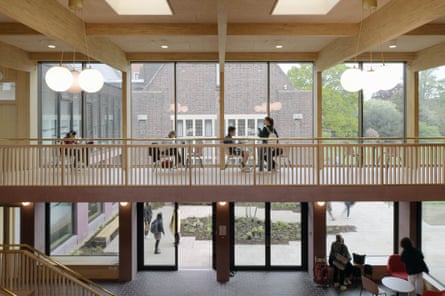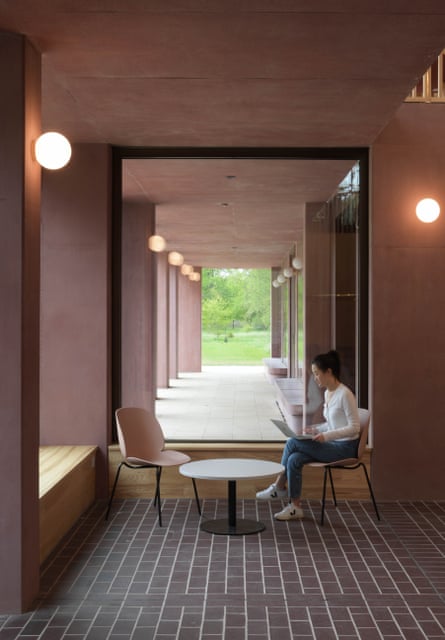Well this is a treat. A new building that is serious and responsible – the Keir Starmer virtues, you could say; adjectives that might be synonyms for dull – that is also sumptuous and surprising, that takes delight in the things that architecture is made of, in materials, space, light and craft. Which is a touch strange and wilful. That takes the risk of looking weird and is rewarded with being beautiful.
This is the new dining hall of Homerton College, Cambridge, built by Barnes Construction of Suffolk and designed by Feilden Fowles – Fergus Feilden and Edmund Fowles – under-40-year-old architects with several accomplished works to their name, in particular in historic and sensitive settings such as Carlisle Cathedral and Yorkshire Sculpture Park. They have sometimes looked as if they were becoming an unimpeachably safe and careful practice of a kind that this country periodically produces. This building, though, is bold.
Homerton, formerly dedicated to training teachers, has only been a full Cambridge college since 2010, and now offers all subjects of the university’s tripos. It is literally on the wrong side of the tracks, reached via a busy road bridge over the railway lines into Cambridge station. Although the college itself stands in pleasant grounds, its neighbourhood lacks the punts and willows and venerable architecture for which the city is famous.
These “perceived minuses”, says Geoff Ward, Homerton’s recently retired principal, are actually “pluses”. It is near the biomedical campus where the likes of AstraZeneca have their headquarters, which creates the possibility of collaboration. The college also has the most diverse intake of any in the university. It offers “a Cambridge education without the Cambridge stereotypes”, was how one student explained its attraction. So its new £10.4m building has to project the confidence of a newly transformed institution and cater to its growing student numbers, while embodying an open and unstuffy spirit.
The college has an older dining hall, which will now be used for receptions and functions and suchlike, in a wannabe neo-gothic that tries too hard to emulate the interiors of the ancient colleges. It is a dark and suffocating place, with the soul of overcooked meat and gravy. It is introverted. The new space, while using the rectangular plan and timber vault of a traditional hall, is both light and full of light.

Glazed openings run along one side, giving generous views into lush gardens. The opposite side opens into humbler spaces, a server and a kitchen beyond, and an informal cafe. The pitched roof of an old-fashioned hall is inverted into a big extruded V of a ceiling, which rises on each side to allow high bands of glazing. Where once there would have been massive oak beams, engineers Structure Workshop have here devised a structure of pale X shapes, manufactured from sweet chestnut coppice, with all the skinniness that modern technology allows.
The timber is held together with interlocking joints and wooden pegs, without any steel bolts or plates, which brings some benefit in terms of sustainability. It is also an example of the sort of unasked-for thoughtfulness in which the building abounds. The wooden panelling of the walls gently corrugates to catch light and shadow. The floor is in shades of grey-green terrazzo in a strong pattern of pointy triangles, subtly complementary to the mulberry-pink concrete that frames the openings to the garden. The colours and shapes quietly zing off one another.

The openness and consideration of the design extends to the kitchens, light-filled and well-organised and visually connected both to surrounding spaces and the outside. A big glass wall on the cafe faces back towards the gable of an older college building, such that it becomes the backdrop of the interior. Every element, historic or functional, has its dignity.
But what really gives the building oomph is its exterior. Here the V-shaped ceiling is expressed as an M-shaped gable at either end of a big box, entirely clad in green faience. The material is mottled and aqueous, always shifting with light and angle of view, catching shadows and bouncing reflections. Flat though it is, it invites you to gaze into its depths.
On the building’s flanks the faience is shaped into a shallow relief of thin vertical triangular shapes, designed to echo a small copper spire on top of the college’s old dining hall. These triangles extend into tall, vertical fins at the top of the elevation, framing the glass panels of the hall’s high-level windows. The whole is placed on a satisfyingly substantial base in that pinkish concrete, where students are invited to sit on built-in benches in its deep openings. Round the back is something else again, a handsome brick structure containing the kitchens.
For the sheer joy of materials, the dining hall is hard to beat: the play of flat and sculpted, matt and shiny, pink and green, the angular faience and rounded shadows formed in the concrete concavities. The way that the superstructure stands on its low base, contrasting in almost every respect, arguably out of proportion, is borderline awkward, but it’s all the more arresting for that. If you wanted to quibble with the architecture you might say that it’s slightly precious and un-radical, a tiny bit complacent in its Cambridge bubble, but you’d have to be in a mean mood to make much of that.

The design also does something to your perception. The exterior cladding makes the building look more solid and opaque than it is, the extensive glazing at the topbarely noticeable amid all the greenish shiny stuff, with the vertical fins hiding the glass in oblique views. This makes the fragility of the interior surprising. What the Tardis does with size the dining hall does with mass: it resembles a big glazed brick on the outside, a balsa wood biplane within, yet these two characters somehow come together to make the same building.
There is, in other words, paradox and inversion. What you see is not what you get. This quality makes the dining hall more than an exercise in good details and well-chosen finishes. It engages your mind and senses. It makes weight and light more palpable. It invites you to understand it through moving round it. By refusing to settle on a single reading, by keeping you guessing as to what precisely it is, the architecture’s ambiguity inoculates it against both grandiosity and blandness.
Architecture gets asked to carry many loads. It is expected to be sustainable and socially virtuous, to be accessible and sensitive to historic settings. Which is as it should be, as it’s a public art, a setting for people’s lives, but in all the concern about doing good, what can be overlooked is what actually makes buildings enjoyable, and what the skills and arts of an architect can contribute.
These might be summarised as doing stuff with stuff, as composing the necessary minerals and volumes of a building in such a way that you are moved, provoked and engaged, and that the experience of whatever it is that goes on in and around it is heightened. Homerton College’s dining hall does right and proper things by the environment and its users. It’s also an architectural pleasure.

Comments (…)
Sign in or create your Guardian account to join the discussion